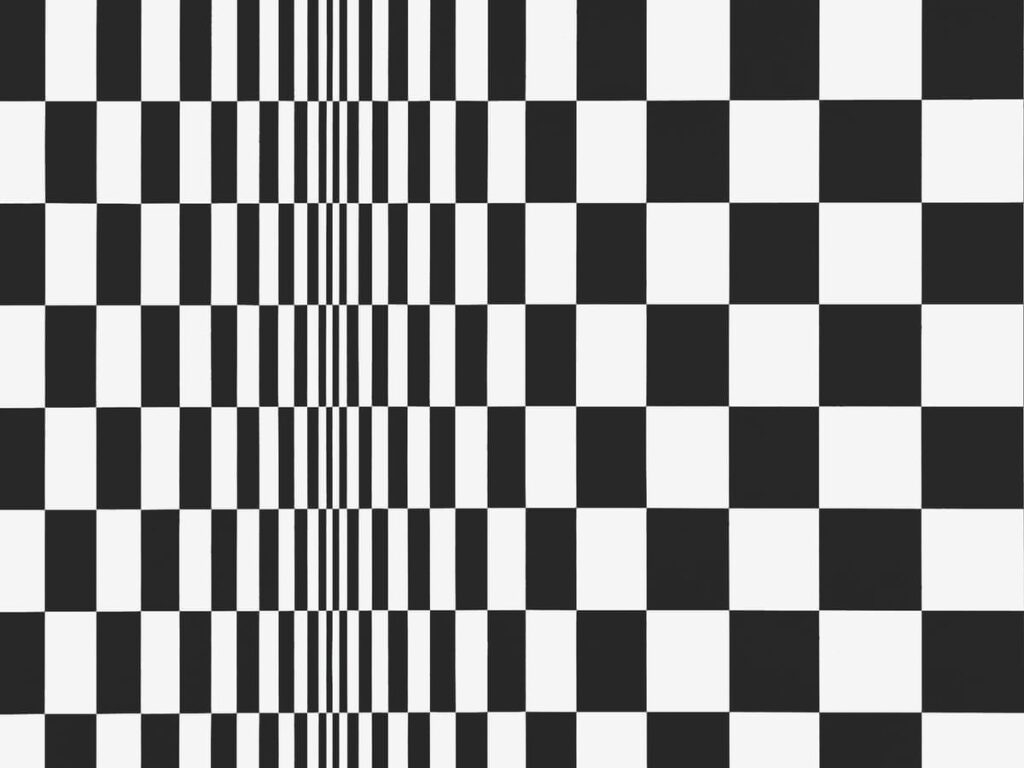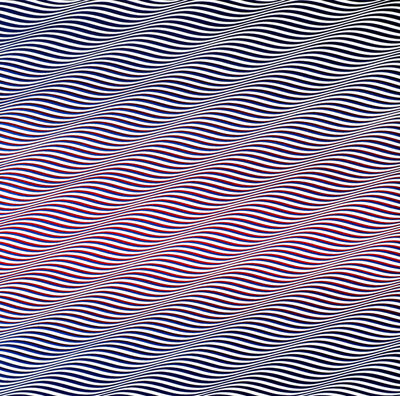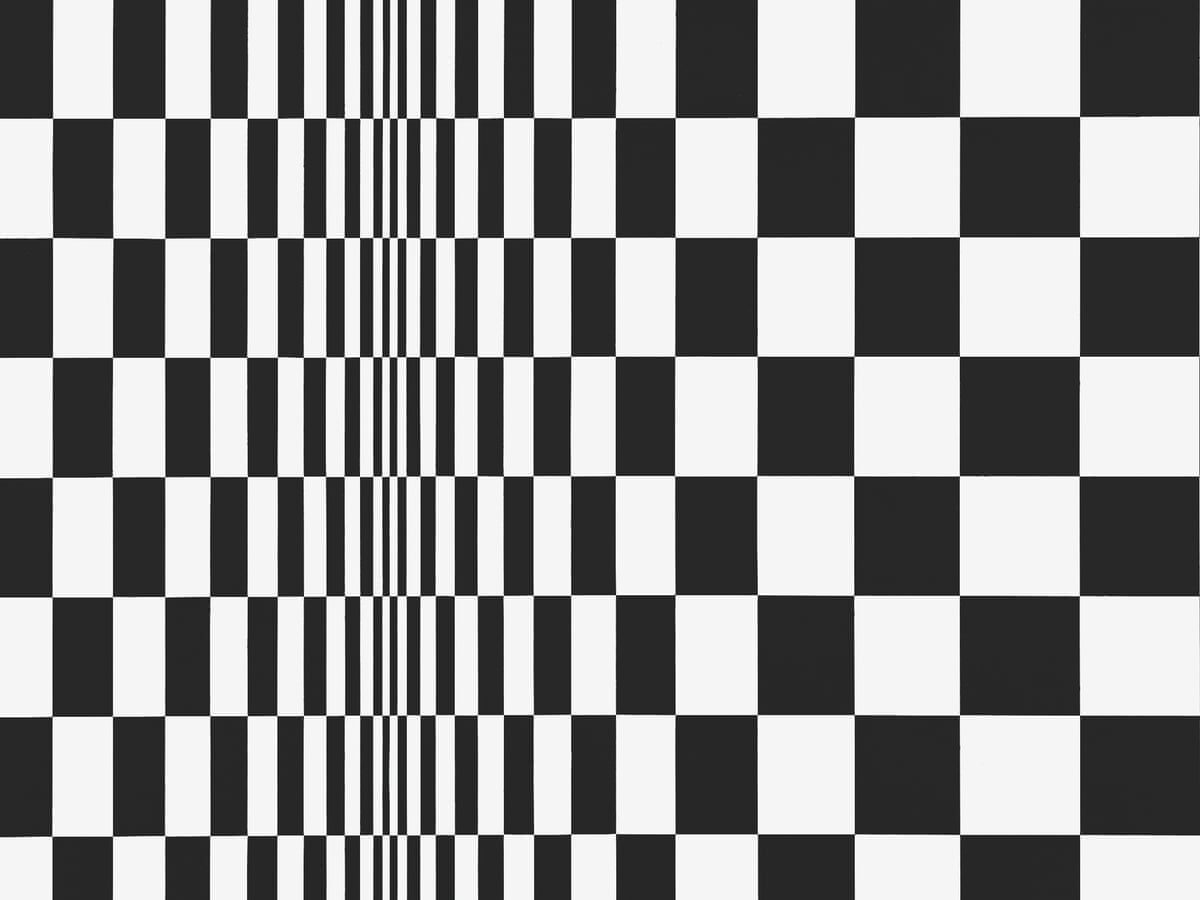Bridget Riley Artwork: Exploring the Evolution and Impact of Op Art
Born: April 24, 1931; Norwood, London, United Kingdom
Art Movement: Op Art
Nationality: British
Influenced By: Georges Seurat
Institution: Royal College of Art
Bridget Riley Artwork: Exploring the Evolution and Impact of Op Art
Bridget Riley’s Artistic Beginnings
Bridget Riley was born in Norwood, London on April 24, 1931. During World War II, she and her family moved to Cornwall to escape the dangers in London. This earlier period was significant as her surroundings deeply influenced her artistic views.

Movement in Squares (1961) by Bridget Riley
Riley’s formal education in art began at Goldsmiths’ College in London from 1949 to 1952. This was followed by her attendance at the Royal College of Art until 1955. During this time, she studied alongside prominent figures and honed her skills.
In her early career, Riley worked at J. Walter Thompson, an advertising agency. This experience exposed her to the interplay of visuals, color, and patterns, which became evident in her later works.
Before the rise of color and optical illusions in her art, Riley painted primarily impressionistic landscapes. Her early work laid the groundwork for exploration in op art.
In 1958, she attended an exhibition that further inspired her trajectory toward abstract designs.
A pivotal piece, “Movement in Squares”, was created in 1961, marking the beginning of her distinctive style. This work illustrates her fascination with shapes and movement, building a bridge from traditional art forms to more experimental approaches.
Throughout these formative years, the influences of her education, work experiences, and geographical moves contributed to the development of her unique style, which would later echo throughout her acclaimed career.
Evolution of Style and Technique

Kiss (1961) by Bridget Riley
Bridget Riley’s art evolved through distinct phases, each marked by innovation and mastery of technique. Her journey illuminates a shift from monochrome patterns to vibrant color explorations, influenced by diverse artistic movements and pioneers.
The Op Art Movement
Riley became a prominent figure in the Op Art movement, which focused on creating optical illusions. Her work featured geometric patterns such as squares, stripes, and curves that produced a disorienting effect on the viewer’s perception.
The 1965 exhibition “The Responsive Eye” showcased these dynamic compositions. Her unique approach to creating movement on a flat surface fascinated audiences and distinguished her within contemporary art.
As her works strategically manipulated the viewer’s sight, they stood alongside the contributions of other Op Art pioneers like Victor Vasarely, emphasizing the dynamism of sight.
Influence of Georges Seurat
A major influence on Riley was Georges Seurat, a leading figure in the development of Pointillism. Seurat’s use of small dots of color to create images greatly impacted Riley’s technique.

Cataract 3 (1967) by Bridget Riley
She applied similar principles in her early work, focusing on optical effects through precise and deliberate arrangements. This method allowed for a new exploration of visual depth and interaction with light and color.
Riley’s adaptation of the pointillist technique showcased her ability to blend historical influences with her own innovative style, bridging the gap between traditional and avant-garde art forms.
Shifts to Color and Form
In the mid-1960s, Riley transitioned to her distinctive use of color, drawing inspiration from artists like Henri Matisse.
This shift involved bright, contrasting hues that maintained her focus on optical illusion while enriching her visual language.
Riley’s exploration with color brought an emotive quality and vibrancy to her work, pushing the boundaries of Op Art.
She creatively utilized geometric forms and vibrant palettes, creating works that engaged both form and color harmoniously.
This transition to a more colorful palette marked a pivotal moment in her career, illustrating her continuous evolution and capacity for artistic transformation.
Key Artworks and Exhibitions

Royal Liverpool Hospital Installation (1983) by Bridget Riley
Bridget Riley is a renowned artist known for her Op Art. She has participated in numerous significant exhibitions that reflect her evolution and impact on the art world. Her key artworks, ranging from black-and-white pieces to bold color compositions, have been displayed in various prestigious venues.
Solo and Group Shows
Bridget Riley’s career features distinguished solo and group exhibitions, contributing to her status in the art world.
One notable solo show was at Gallery One, organized by Victor Musgrave, marking an important milestone in her career. She later showcased her works at the Whitechapel Gallery and Hayward Gallery, where retrospectives highlighted her artistic journey.
Riley’s work was also a part of the seminal exhibition The Responsive Eye at the Museum of Modern Art, which brought Op Art to widespread attention.
Her artworks, such as “Cataract 3” and “Egyptian Palette,” illustrate her mastery of visual effects.
Significant Global Presence
Riley’s influence was felt globally when she became the first woman to win the painting prize at the Venice Biennale in 1968. This recognition solidified her position on the international stage.

Red with Red 1 (2007) by Bridget Riley
Her exhibitions have been held in major galleries like Tate Gallery and National Gallery, showcasing both her early black-and-white paintings and later vibrant color works.
Exhibitions at locations like David Zwirner have continued to bring her art to new audiences.
The Hayward Gallery presented a comprehensive retrospective in 2019, co-organized with the National Galleries of Scotland. This exhibition covered seven decades, reinforcing her lasting impact on both European and American art.
Intersection with Other Artists
Throughout her career, Bridget Riley collaborated with and influenced a variety of artists.
She co-founded the artist organization SPACE with Peter Sedgley and journalist Peter Townsend, which provided a platform for artist collaboration and innovation.
Her work has inspired a generation of Op artists, including Richard Allen and Richard Anuszkiewicz. The cultural dialogue her art fosters often intersects with other creative disciplines.
Riley’s link with galleries like the Richard Feigen Gallery and her participation in collaborative projects have enriched her dynamic presence in the art community, demonstrating the reciprocal relationships between her and her contemporaries.
Cultural and Academic Impact
Bridget Riley has had a profound influence on both the art world and academia. Her work in Op Art redefined perception, focusing on optical illusions, movement, and rhythm.

Fete (1989) by Bridget Riley
Her painting Movement in Squares became a seminal piece, contributing to the understanding of optical illusions in art.
She was featured in The Responsive Eye, a major exhibition in 1965 at the Museum of Modern Art in New York. This event solidified Op Art as a significant art movement, showcasing Riley’s innovative use of color and geometry. The exhibition reached international audiences, enhancing her reputation.
Riley’s work has been compared to the Italian Futurists, who also explored movement and dynamism. However, Riley’s approach is distinctive with its focus on the optical experience rather than themes of industrialization.
Her artwork is a staple in museums worldwide, including the Tate, illustrating her ongoing relevance.
Academically, Riley’s exploration of visual phenomena and perception has inspired research and discussions in art and psychology.
Her experiments with color and form challenge viewers’ perception, making her a subject of study in university art programs.
Throughout her career, Riley has received numerous accolades.
Her art won the International Prize for Painting at the Venice Biennale in 1968. She has also been recognized with the British Council AICA Critics Prize and the Peter Stuyvesant Foundation Travel Bursary.
Riley’s influence extends beyond her studio. She has roots in various places, including Vaucluse, Yorkshire, and Padstow, which have inspired her work, particularly in her landscape pieces. Through her contributions, Bridget Riley has left a lasting legacy in the cultural and academic realms.
Frequently Asked Questions
Bridget Riley is a renowned artist known for her contributions to the Op Art movement and her exploration of visual perception. Her works, such as “Movement in Squares” and “Pink Landscape,” highlight her skill in using geometric patterns and colors to create optical effects.
What is the significance of Bridget Riley’s ‘Movement in Squares’?
“Movement in Squares,” created in 1961, marks a pivotal point in Riley’s career. The artwork uses black and white squares to create a sense of movement and tension. It demonstrates her interest in the illusion of depth and motion, making it a key piece in the Op Art movement.
How did Bridget Riley contribute to the Op Art movement?
Bridget Riley is one of the leading figures in Op Art, a style that emerged in the 1960s. Through her intricate patterns and optical illusions, she pushed the boundaries of how viewers perceive movement and light, influencing other artists and expanding the possibilities of visual art.
What are notable characteristics of Bridget Riley’s ‘Pink Landscape’?
“Pink Landscape” displays Riley’s exploration of color interaction and its emotional impact. By combining various shades of pink with contrasting hues, she creates a vibrant and dynamic composition. The painting invites viewers to experience the emotional resonance of colors interacting on the canvas.
Can you list five influential facts about Bridget Riley’s life and career?
- Riley initially trained as a figurative painter before moving to abstraction.
- She was born in 1931 and studied at Goldsmiths College and the Royal College of Art.
- Her work “Untitled (Oval Image)” sold for £65,000 in 2024.
- Riley received the prestigious International Prize for Painting at the Venice Biennale in 1968.
- Her artwork is known for exploring visual perception and optical illusions.
What is Bridget Riley’s role in contemporary art today?
Bridget Riley remains an influential figure in contemporary art. Her innovative techniques continue to inspire modern artists. Exhibitions of her work attract large audiences, highlighting her impact on visual art and her ongoing relevance in the art community.
How has Bridget Riley’s work evolved throughout her career?
Riley’s early work focused on black and white patterns. Over time, she began experimenting with color and more complex designs. Her evolution shows a deepening interest in how color and form interact. This resulted in a diverse body of work that spans several decades.









